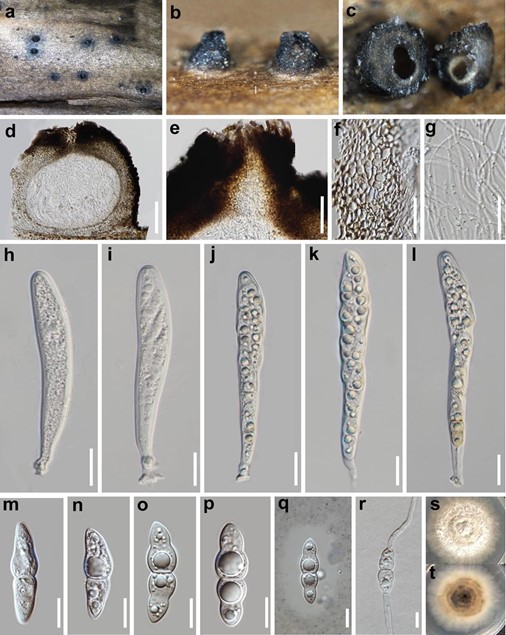Crassoascoma potentillae Z.P. Liu, S.N. Zhang and Jian K. Liu, sp. nov. Figure 2
MycoBank number: MB 841099; Index Fungorum number: IF 841099; Facesoffungi number: FoF;
Etymology: Name “potentillae” referred to the hosts Potentilla fruticosa L. on which the fungus was collected.
Holotype: HKAS 115966
Saprobic on the epidermis of decayed wood in semiarid lands. Sexual morph: Ascomata 270–340 µm high, 270–320 µm diam. superficial, scattered, subglobose to globose, base flattened, dark brown to black, uni-loculate, rough walled, papillate. Ostiole 90–110 µm wide, 100–120 µm high, central, dark brown, with brown setae on the papilla. Peridium 28–37 µm wide, relatively thick, multi-layer, comprising pale brown to brown cells of textura angularis. Hamathecium 1.7–2.3 µm wide, trabeculate pseuoparaphyses, remotely septate, filamentous and anastomosing. Asci 139–155 × 18–20 µm (x = 147 × 17 µm, n = 20), 8-spored, bitunicate, fissitunicate, clavate to subcylindrical, shortly pedicellate, apically rounded with an ocular chamber. Ascospores 31–35 × 7–8 µm (x = 33 × 6.5 µm, n = 50), overlapping biseriate, usually uniseriate in the lower half, fusiform with subobtuse to acute ends, straight or slightly curved, hyaline, rarely pale brown, one-septate, the upper cell slightly bigger than the lower cell, constricted at the septum and midpoint of each cell, smooth-walled, surrounded by an entire mucilaginous sheath. Asexual morph: undetermined.
Culture characteristics: Ascospores germinated on PDA within 24 h. Colonies on PDA reaching 24 mm diam. incubated at 25 ◦C after 4 weeks, circular, medium dense, cottony, flat to raised, entire margins, greyish-white, thinner and velvety at the margin, pale brown to brown from the reverse.
Material examined: CHINA. Qinghai province, Huangnan autonomic prefecture, Zeku city, Maixiang district S203 road, 35◦16′27′′ N, 101◦54′48′′ E, 3315 m, on the branch of Potentilla fruticosa L. (Rosaceae), 21 July 2020, Jian-Kui Liu, HUEST 21.0015 (HKAS 115966, holotype; ex-type living culture CGMCC 3.20483 = UESTCC 21.0013); ibid., Gansu Province, Zhangye city, Minle county, 38◦23′2′′ N, 100◦22′30′′ E, 2830 m, on the branch of Potentilla fruticosa L., 2 August 2020, Jian-Kui Liu, HUEST 21.0013 (HKAS 115967, paratype); living culture UESTCC 21.0011; ibid., Gansu Province, Zhangye City, Minle County, 38◦23′2′′ N, 100◦22′30′′ E, 2830 m, on the branch of Potentilla fruticosa L., 2 August 2020, Jian-Kui Liu, HUEST 21.0014; living culture UESTCC 21.0012; ibid., Gansu Province, Jiuquan City, Sunan County, Kangle Township, 38◦47′50′′ N, 99◦40′53′′ E, 2456 m, on the branch of Potentilla fruticosa L., 2 August 2020, Jian-Kui Liu, HUEST 21.0012, living culture UESTCC 21.0010.
Notes: Four of our Crassoascoma isolates clustered together and almost identical in their ITS, TEF1-α sequence data, which indicated they can be recognized as a single species. The distinguishing characteristics of Crassoascoma potentillae are the superficial, globose, black, thick-walled ascomata with setae on the papilla, and fusiform, one-septate, hyaline (rarely pale brown) ascospores with subobtuse ends, constricted at the septum and midpoint of each cell and surrounded by a mucilaginous sheath.

Figure 2. Crassoascoma potentillae (HKAS 115966, holotype) (a–c) Ascomata on host surface. (d) Vertical section of ascomata. (e) Ostiole. (f) Peridium. (g) Hamathecium. (h–l) Asci, (m–p) Ascospores.
(q) Ascospore stained with India ink showing the mucilaginous sheath. (r) Germinating ascospore. (s,t) Colony on PDA (4 weeks). Scale bars: d = 100 µm, e = 50µm, (f–l), r = 20 µm, (m–q) = 10 µm.
